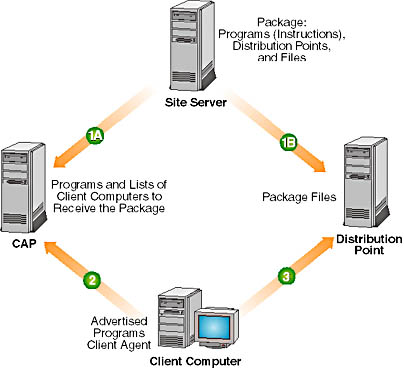Lesson 1: Overview of Software Distribution
Almost any software or data can be distributed by SMS and shipped to client computers. The first step in SMS software distribution is creating a package and a program. A package contains the data or software that needs to be distributed and installation instructions. A program contains an installation instruction contained in the package. Next, an advertisement is used to send the package and program to a collection. A collection contains at least one client computer and, optionally, subcollections. A subcollection is simply a collection included within another collection. Finally, the Advertised Programs Client Agent receives the package and runs the program included in the advertisement on the client computer. Installation instructions can be created for packages using the SMS Installer application.
After this lesson, you will be able to:
- Explain the components that make software distribution possible in SMS 2.0.
What Can Be Distributed?
With the software distribution feature, single files or entire applications can be distributed, as packages, to distribution points in a Systems Management Server (SMS) hierarchy. If instructions without files must be sent, the software distribution feature can be used to distribute instructions-only packages to client computers. In this case, distribution points are not used to distribute the package. An instruction-only package can be used to run regularly scheduled maintenance tasks such as disk defragmentation. If a package contains files, distribution points are specified during package creation. For all packages, advertisements send package instructions to CAPs.
NOTE
The client access point (CAP) is a site system whose role is to provide a set of shared directories and files that create a common communications point between the site server and the client computers.
The Advertised Programs Client Agent running on the client computer installs the application or simply runs a command using an instruction sent to the CAP. Advertisements and packages are intentionally separated in SMS so that multiple advertisements can be created to execute any instruction in a previously distributed package.
The software distribution process typically includes:
- Installing or removing software
- Copying data files to client computers
- Running utilities such as virus checkers or disk defragmenters
Commands are run on the client computer by the Advertised Programs Client Agent. It uses a package that is the combination of the application's files and a program (the actual command to run the application).
A program that cannot be run at a client computer is ignored. The Advertised Programs Client Agent on a Windows 16-bit client computer, for example, will ignore packages intended for Windows 32-bit client computers.
Supported Client Computers
Any client computer that has the Advertised Programs Client Agent installed and is a member of a collection is considered a package target. The following client operating systems are supported directly by SMS 2.0:
- Windows 16-bit operating systems (Windows 3.x and Windows for Workgroups)
- Windows 32-bit operating systems (Windows 95/98 and Windows NT/2000)
To support client computers running MS-DOS 5.0 or later, Macintosh System 7.x, OS/2 2.x, and OS/2 Warp with Windows, maintain an SMS 1.2 site server in the SMS 2.0 site hierarchy. Packages can be created on the SMS 2.0 site server or created on the SMS 1.2 site server. Packages will then run as SMS 1.2 Run Command on Workstation jobs. If Windows 16-bit or Windows 32-bit client computers are managed by an SMS 1.2 site server, then Share Package on Server jobs are also supported from the site servers.
Configuring Software Distribution
A package is configured at the site server, made available on distribution points if necessary, and run on the client computer using instructions from the CAP. Figure 4-1 shows the entire software distribution process.

Figure 4-1. An overview of the software distribution process.
The process of distributing software or commands to client computers is described in the sections that follow.
Procedures Completed on the Site Server
- Create a package from the Packages node of the SMS Administrator console.
- Create an advertisement using the Advertisements node.
In the package's properties, determine which site systems, if any, will be distribution points for the package; what programs should be part of the package; and whether default security settings for the package should be adjusted.
In the advertisement's properties select a package, a program within the package, and a collection target. A schedule for advertisement availability and security settings can also be configured.
The Distribution Process
- A package is placed on the distribution point.
- Instruction files are created for each advertisement and placed on the CAP.
- The Advertised Programs Client Agent reads instruction files placed on a CAP.
The Advertised Programs Client Agent recognizes which package is destined for the client computer by matching the client computer's globally unique identifier (GUID), or a user name, or a group name with the offers placed on the CAP. The Advertised Programs Client Agent presents the user with available packages for installation.
NOTE
A GUID is globally unique across computers and networks because it is created from a time stamp and a code based on the network address hardwired on the host computer.
- A connection to a distribution point is established.
Using the program instructions contained on the CAP, the Advertised Programs Client Agent connects to a valid distribution point containing the package to be installed. The instructions then provide the information needed by the client agent to run a procedure such as software installation.
EAN: 2147483647
Pages: 107